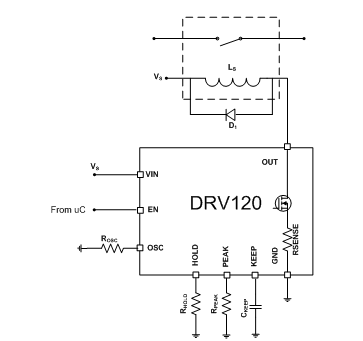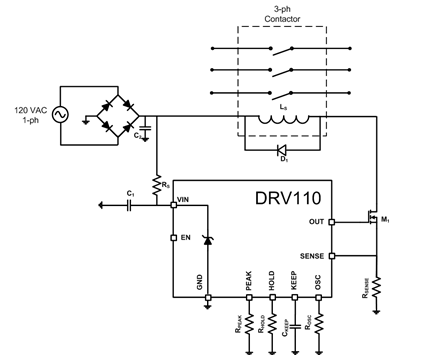SSZTAC3 march 2017 DRV110 , DRV120
One of the things I love about my job as an applications engineer is pretending that I’m a TI customer. I spend my days dreaming of all the possible ways customers use solenoids, design solenoids and drive solenoids. Today, I’m considering what concerns TI customers might have regarding voltage supply and solenoid or relay selection.
One customer I can imagine is a valve designer – maybe pneumatics in factory automation or media valves for process automation. Most factory- and process-automation equipment is designed for 24V supplies. However, customers may have control signals for a wide range of AC or DC voltages – 12 V, 24 V, 36 V, 48V, or even 120 or 240 V for some valves and contactors. To accommodate all of these voltages, I would need to design five different coils and have five separate products.
One solution could be to design one coil for 12V, then use a resistor to limit the current into the solenoid for each voltage option. However, this wastes energy and could dissipate a lot of heat from the resistor, especially if the 12-V coil is used for the 220V design.
Another, more energy-efficient solution is to use pulse-width modulation (PWM) driving and a freewheeling diode to regulate the current in the solenoid. Additionally, you could add current-sense feedback with PWM and control the current in the solenoid. The magnetic force produced by the solenoid to open or close a valve depends on the current flowing through the solenoid coil. The solenoid resistance increases with temperature. With an applied voltage, the increase in resistance will reduce the current in the solenoid, which reduces the magnetic force. At high temperatures, it is possible for the solenoid to de-actuate or for a relay to open its contacts if the current decreases too much. With current control, the solenoid current is always regulated to the required value independent of temperature, which makes the system more reliable and robust over temperature. You could implement current-sense feedback with a microcontroller and discrete signal-chain components, or with an integrated solenoid driver like the DRV110 (Figure 2) and DRV120 (Figure 1).
 Figure 1 The DRV120
Driving a Relay Using Current Control
Figure 1 The DRV120
Driving a Relay Using Current ControlFigure 2 shows how you can configure the DRV110 solenoid to accommodate AC voltages that energize solenoid valves or contactors. By using DC to drive the contactor instead of AC, you can simplify the design of the magnetics by eliminating the need for a shaded ring in the core.
 Figure 2 DRV110 Used to Drive the Coil
for an AC Contactor
Figure 2 DRV110 Used to Drive the Coil
for an AC ContactorWith this current-control technique, you can potentially design only one 12-V coil for the force requirements of the AC or DC 12-V to 48-V valves and the AC 120-V to 220V valves. This allows you to have multiple product offerings for valves while only needing to design one coil.
Another customer situation I can imagine is wanting to use a particular relay in a design, but the only supply rail available is too high. Let’s say that the relay is rated for 12 V, but the supply rail is 24V. One solution may be to just switch to a 24V relay for the system. While it sounds easy, perhaps that involves adding the new part number as an approved component. Maybe you can’t do this because it is a difficult or lengthy process, and you want to take your product to market quickly. You might also run into the same situation with a solenoid. Perhaps you really like the force of a particular solenoid, but it’s rated for 12 V when you have a 24-V rail.
Using current control can also solve this dilemma. You can use your 12V relay or solenoid for both 12-V and 24-V systems. Maybe the next-generation product will only have a 36-V supply rail. Even in that case, current control will allow you to continue using your chosen solenoid or relay. Perhaps by using the same solenoid in all three systems, you can get a volume discount from the solenoid/relay manufacturer for purchasing large volumes of that particular part number.
With current feedback, I solved my imaginary customers’ issues for voltage supply rail and solenoid/relay design or part-number selection. Is my imagination accurate to your design experience? Please share your experience in the comments or share any other great solenoid- or relay-driving solutions.
Additional Resources
- Explore a 230VAC solenoid reference design that illustrates how to integrate current control.
- Check out another reference design that provides a solution to control solenoid current using a PWM-based controller.